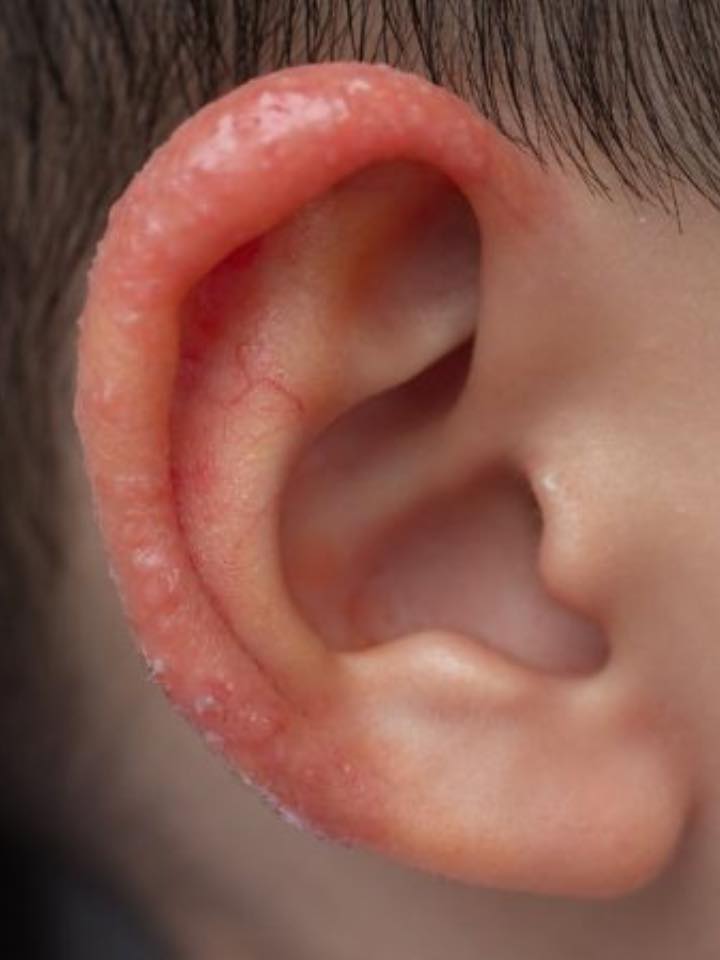Discovering strange, angry skin on your child’s ear can feel like an alarm that won’t stop ringing. It’s sudden, alarming, and utterly confusing. You may have been playing together just moments ago, laughing, and then you notice it—a patch of redness, a tiny bump, or flaky skin—and suddenly, a wave of worry crashes over you. Your mind races with questions: What caused this? Is it an allergy? An infection? Something more serious? How quickly will it spread? And worst of all, the doctor’s office can’t see you until next week. Every scratch, every rub, every tiny irritation becomes magnified in those long hours, each one making your anxiety grow. You find yourself watching your child constantly, noticing the smallest changes, every twinge of discomfort tugging at your nerves.
The first step in facing this uncertainty is grounding yourself and approaching the situation calmly. Children are highly attuned to their parents’ emotions, so panicking can amplify their own discomfort. Take a deep breath and gather yourself before examining your child’s ear. Good lighting is essential: natural daylight or a well-lit room will allow you to see redness, bumps, dryness, or crusting more clearly. Observe carefully for swelling, unusual textures, or any fluid that might indicate infection. While you examine the area, speak gently to your child. Explain what you’re doing in simple terms: “I’m just looking at your ear to make sure it’s okay.” This reassures them that they are safe, and it helps reduce stress and resistance during the check.
Scratching is one of the biggest threats to irritated skin. Even a small itch can escalate into raw, broken skin that becomes a gateway for infection. To prevent this, keep your child’s nails short and clean, and if needed, use light cotton gloves or cover the hands at night to limit unconscious scratching during sleep. Encourage gentle touching and reassure them frequently, “I know it itches, but let’s be careful so your skin can heal.” Distraction techniques—like reading a book, playing a quiet game, or listening to music—can also help redirect attention from the irritation.
Maintaining cleanliness is vital. Avoid harsh soaps, scented shampoos, or antibacterial washes that can strip the skin’s natural oils and worsen irritation. A gentle rinse with lukewarm water and a mild, fragrance-free cleanser is usually sufficient. Pat the area dry rather than rubbing, and consider using a soft, clean cloth to prevent friction. Keeping the ear dry and protected while still allowing it to breathe can prevent minor irritations from developing into more serious conditions.
Home care can provide comfort while you await professional evaluation. A cool, damp cloth applied to the affected area can reduce warmth and inflammation. Applying a bland, fragrance-free moisturizer can soothe dryness and prevent cracking. In some cases, a short, careful application of over-the-counter hydrocortisone cream—only as directed by packaging or a pharmacist—may reduce itching and inflammation. However, these measures are only for temporary relief and do not replace a proper medical diagnosis.
Documenting your observations is immensely helpful for your child’s appointment. Note the size, shape, and color of the affected area, and track any changes over time. Record potential triggers such as new foods, detergents, soaps, earrings, or environmental exposures. This record allows the doctor to quickly understand the progression, improving the accuracy of diagnosis and the effectiveness of treatment.
Watch vigilantly for warning signs that indicate urgent care is needed. Spreading redness, warmth to the touch, pus or fluid drainage, fever, or increasing pain are all signals that an infection may be developing or that another underlying condition requires immediate attention. In such cases, do not wait for the next routine appointment—seek medical care promptly.
Through all this, your child’s emotional well-being is just as important as their physical health. Comfort, reassurance, and gentle attention help them feel safe, even when the situation is confusing or uncomfortable. By staying calm, observant, and proactive, you empower yourself and provide stability for your child. You cannot control every detail of what is happening under the skin, but you can control how you respond—with patience, care, and informed action.
In the end, these measures—careful observation, home comfort, documentation, and timely medical attention—create a bridge over the anxiety-filled hours. They help you turn fear into manageable action, and while the itch and redness may be troubling now, your child will know that they are seen, supported, and loved through every uncomfortable moment until help arrives.
